The Automotive Catalytic Converter Market is estimated to be valued at USD 182.1 billion in 2025 and is projected to reach USD 415.6 billion by 2035, registering a compound annual growth rate (CAGR) of 8.6% over the forecast period.
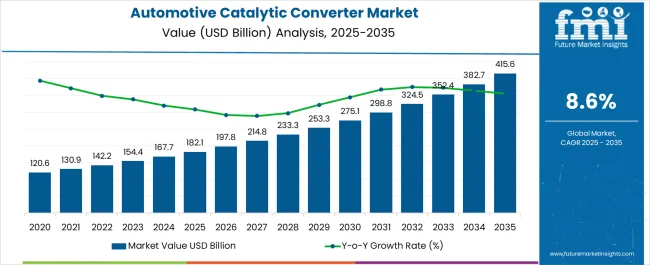
| Metric | Value |
|---|---|
| Automotive Catalytic Converter Market Estimated Value in (2025 E) | USD 182.1 billion |
| Automotive Catalytic Converter Market Forecast Value in (2035 F) | USD 415.6 billion |
| Forecast CAGR (2025 to 2035) | 8.6% |
The Automotive Catalytic Converter market is experiencing robust growth, driven by the increasing emphasis on reducing vehicular emissions and meeting stringent environmental regulations worldwide. Rising demand for fuel-efficient vehicles and the adoption of advanced emission control technologies are contributing to market expansion. Government initiatives targeting carbon reduction, stricter emission standards, and incentives for green automotive technologies are further accelerating the adoption of catalytic converters across passenger and commercial vehicles.
Technological advancements in catalyst materials, coating techniques, and converter designs are enhancing efficiency and durability, while also supporting compliance with evolving environmental regulations. The integration of emission control systems with engine management technologies is enabling optimized performance and lower fuel consumption.
As automotive manufacturers prioritize sustainability and regulatory compliance, the market is expected to witness continued growth Investments in research and development for high-performance catalysts, lightweight designs, and cost-effective manufacturing processes are further supporting market expansion, positioning catalytic converters as essential components in both conventional and hybrid vehicles.
The automotive catalytic converter market is segmented by sales channel, material, product type, and geographic regions. By sales channel, automotive catalytic converter market is divided into Aftermarket and Original Equipment Manufacturer (OEM). In terms of material, automotive catalytic converter market is classified into Platinum, Rhodium, Palladium, and Others. Based on product type, automotive catalytic converter market is segmented into Three-Way Catalytic Converter, Lean NOx Trap, Selective Catalytic Reduction, and Diesel Oxidation Catalytic Converter. Regionally, the automotive catalytic converter industry is classified into North America, Latin America, Western Europe, Eastern Europe, Balkan & Baltic Countries, Russia & Belarus, Central Asia, East Asia, South Asia & Pacific, and the Middle East & Africa.
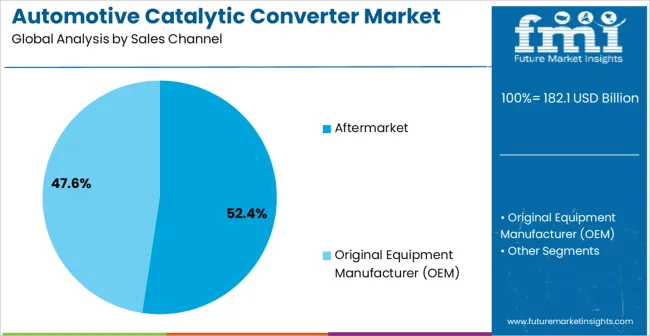
The aftermarket sales channel segment is projected to hold 52.4% of the market revenue in 2025, establishing it as the leading channel. Growth is being driven by the increasing replacement and retrofit demand for catalytic converters across aging vehicles. Aftermarket channels offer flexible options for maintenance, repair, and upgrades, ensuring compliance with evolving emission regulations without requiring full vehicle replacement.
The segment benefits from widespread availability of distributors, workshops, and service providers that facilitate convenient installation and servicing. Rising awareness of emission standards and environmental responsibility among vehicle owners is further fueling aftermarket adoption. Technological improvements in converter designs, including longer service life and improved efficiency, have strengthened customer confidence in aftermarket options.
Cost advantages compared to original equipment manufacturer solutions also contribute to growth As vehicle fleets expand and older vehicles remain in operation, the aftermarket segment is expected to continue leading revenue share, supported by increasing regulatory enforcement and growing consumer demand for emission-compliant solutions.
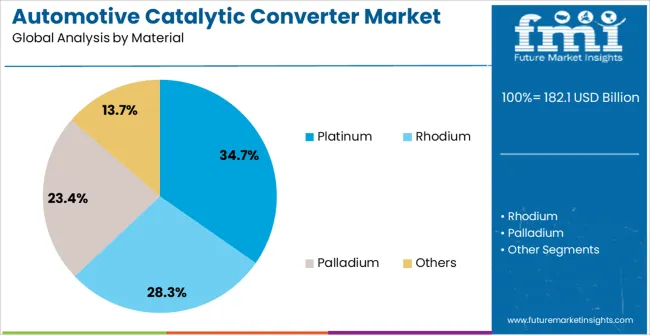
The platinum material segment is expected to account for 34.7% of the market revenue in 2025, making it the leading material choice. Growth is driven by the superior catalytic properties of platinum, which enable efficient oxidation and reduction reactions, ensuring compliance with stringent emission standards. Platinum-based converters provide high thermal stability and durability, maintaining performance over extended operational cycles and under varying engine conditions.
Manufacturers prefer platinum for its reliability and effectiveness in reducing nitrogen oxides, hydrocarbons, and carbon monoxide emissions. Advancements in catalyst coating technologies have enhanced material utilization efficiency, lowering overall production costs while maintaining performance.
Rising investments in clean automotive technologies and emission control systems are further reinforcing demand The combination of regulatory compliance, long-term durability, and consistent catalytic efficiency ensures that platinum continues to dominate material selection in automotive catalytic converters.
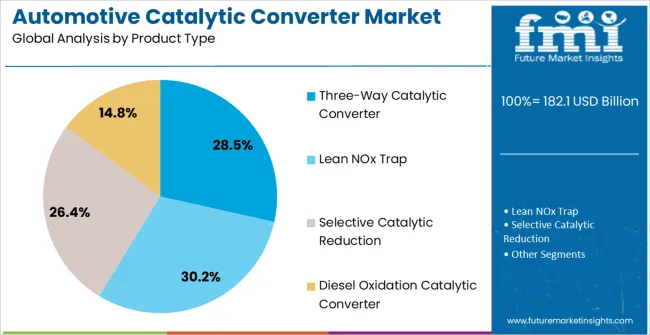
The three-way catalytic converter segment is projected to hold 28.5% of the market revenue in 2025, establishing it as the leading product type. Its adoption is driven by its ability to simultaneously reduce nitrogen oxides, carbon monoxide, and hydrocarbons, which is critical for meeting stringent emission regulations in gasoline-powered vehicles. Advanced three-way converters are being integrated with engine management systems to optimize performance and fuel efficiency while minimizing exhaust pollutants.
The product type benefits from continuous innovation in catalyst formulations, coating techniques, and substrate designs, which improve efficiency, durability, and thermal resistance. Growing awareness of environmental regulations and increased focus on sustainability are further driving demand.
Automotive manufacturers are leveraging three-way converters to comply with evolving standards, reduce operational costs, and enhance vehicle marketability As emission reduction remains a top priority for both regulators and manufacturers, three-way catalytic converters are expected to maintain their leadership position in product revenue share, supported by technological advancements and widespread adoption.
Automotive industry is expected to witness substantial growth in the near future with increasing heavy investments on research and development by the automotive manufacturers and stringent emission control rules and regulations across the globe. These factors are expected to stimulate demand and supply of new and innovative automotive catalytic converter technologies and its adoption rate in vehicles is expected to increase in the forthcoming years.
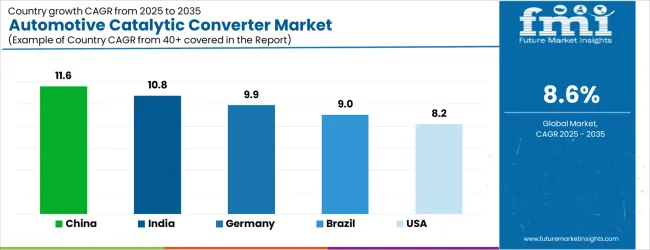
| Country | CAGR |
|---|---|
| China | 11.6% |
| India | 10.8% |
| Germany | 9.9% |
| Brazil | 9.0% |
| USA | 8.2% |
| UK | 7.3% |
| Japan | 6.5% |
The Automotive Catalytic Converter Market is expected to register a CAGR of 8.6% during the forecast period, exhibiting varied country level momentum. China leads with the highest CAGR of 11.6%, followed by India at 10.8%. Developed markets such as Germany, France, and the UK continue to expand steadily, while the USA is likely to grow at consistent rates. Japan posts the lowest CAGR at 6.5%, yet still underscores a broadly positive trajectory for the global Automotive Catalytic Converter Market. In 2024, Germany held a dominant revenue in the Western Europe market and is expected to grow with a CAGR of 9.9%. The USA Automotive Catalytic Converter Market is estimated to be valued at USD 63.9 billion in 2025 and is anticipated to reach a valuation of USD 63.9 billion by 2035. Sales are projected to rise at a CAGR of 0.0% over the forecast period between 2025 and 2035. While Japan and South Korea markets are estimated to be valued at USD 8.5 billion and USD 5.7 billion respectively in 2025.
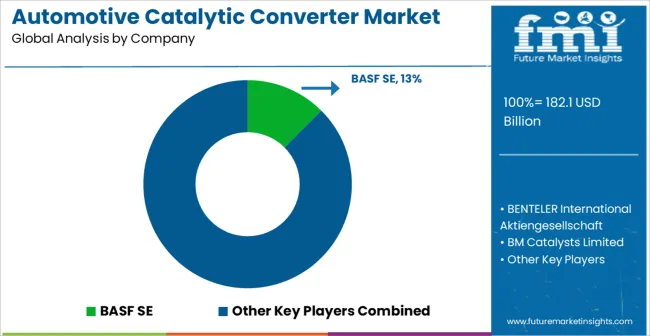
| Item | Value |
|---|---|
| Quantitative Units | USD 182.1 Billion |
| Sales Channel | Aftermarket and Original Equipment Manufacturer (OEM) |
| Material | Platinum, Rhodium, Palladium, and Others |
| Product Type | Three-Way Catalytic Converter, Lean NOx Trap, Selective Catalytic Reduction, and Diesel Oxidation Catalytic Converter |
| Regions Covered | North America, Europe, Asia-Pacific, Latin America, Middle East & Africa |
| Country Covered | United States, Canada, Germany, France, United Kingdom, China, Japan, India, Brazil, South Africa |
| Key Companies Profiled | BASF SE, BENTELER International Aktiengesellschaft, BM Catalysts Limited, BOSAL, Marelli Corporation, Calsonic Kansei, Deccats, Eberspächer, European Exhaust & Catalyst Ltd, FORVIA Faurecia, HJS Emission Technology GmbH & Co. KG, Jetex Exhausts Ltd, Katcon SA de CV, Klarius Products Ltd, Marelli Holdings Co., Ltd., and Tenneco, Inc. |
The global automotive catalytic converter market is estimated to be valued at USD 182.1 billion in 2025.
The market size for the automotive catalytic converter market is projected to reach USD 415.6 billion by 2035.
The automotive catalytic converter market is expected to grow at a 8.6% CAGR between 2025 and 2035.
The key product types in automotive catalytic converter market are aftermarket and original equipment manufacturer (oem).
In terms of material, platinum segment to command 34.7% share in the automotive catalytic converter market in 2025.






Our Research Products

The "Full Research Suite" delivers actionable market intel, deep dives on markets or technologies, so clients act faster, cut risk, and unlock growth.

The Leaderboard benchmarks and ranks top vendors, classifying them as Established Leaders, Leading Challengers, or Disruptors & Challengers.

Locates where complements amplify value and substitutes erode it, forecasting net impact by horizon

We deliver granular, decision-grade intel: market sizing, 5-year forecasts, pricing, adoption, usage, revenue, and operational KPIs—plus competitor tracking, regulation, and value chains—across 60 countries broadly.

Spot the shifts before they hit your P&L. We track inflection points, adoption curves, pricing moves, and ecosystem plays to show where demand is heading, why it is changing, and what to do next across high-growth markets and disruptive tech

Real-time reads of user behavior. We track shifting priorities, perceptions of today’s and next-gen services, and provider experience, then pace how fast tech moves from trial to adoption, blending buyer, consumer, and channel inputs with social signals (#WhySwitch, #UX).

Partner with our analyst team to build a custom report designed around your business priorities. From analysing market trends to assessing competitors or crafting bespoke datasets, we tailor insights to your needs.
Supplier Intelligence
Discovery & Profiling
Capacity & Footprint
Performance & Risk
Compliance & Governance
Commercial Readiness
Who Supplies Whom
Scorecards & Shortlists
Playbooks & Docs
Category Intelligence
Definition & Scope
Demand & Use Cases
Cost Drivers
Market Structure
Supply Chain Map
Trade & Policy
Operating Norms
Deliverables
Buyer Intelligence
Account Basics
Spend & Scope
Procurement Model
Vendor Requirements
Terms & Policies
Entry Strategy
Pain Points & Triggers
Outputs
Pricing Analysis
Benchmarks
Trends
Should-Cost
Indexation
Landed Cost
Commercial Terms
Deliverables
Brand Analysis
Positioning & Value Prop
Share & Presence
Customer Evidence
Go-to-Market
Digital & Reputation
Compliance & Trust
KPIs & Gaps
Outputs
Full Research Suite comprises of:
Market outlook & trends analysis
Interviews & case studies
Strategic recommendations
Vendor profiles & capabilities analysis
5-year forecasts
8 regions and 60+ country-level data splits
Market segment data splits
12 months of continuous data updates
DELIVERED AS:
PDF EXCEL ONLINE
Automotive Three Way Catalytic Converter Market Size and Share Forecast Outlook 2025 to 2035
Automotive DC-DC Converter Market Size and Share Forecast Outlook 2025 to 2035
Automotive Torque Converter Market Size and Share Forecast Outlook 2025 to 2035
Industrial Catalytic Converters Market
Automotive Direct Liquid Cooling IGBT Module Market Size and Share Forecast Outlook 2025 to 2035
Automotive Hoses and Assemblies Market Size and Share Forecast Outlook 2025 to 2035
Automotive Network Testing Market Size and Share Forecast Outlook 2025 to 2035
Automotive Performance Part Market Size and Share Forecast Outlook 2025 to 2035
Automotive Carbon Ceramic Brake Market Size and Share Forecast Outlook 2025 to 2035
Automotive Camshaft Market Size and Share Forecast Outlook 2025 to 2035
Automotive Stamping Industry Analysis in India Size and Share Forecast Outlook 2025 to 2035
Automotive Cylinder Liner Market Size and Share Forecast Outlook 2025 to 2035
Automotive Microcontroller Market Size and Share Forecast Outlook 2025 to 2035
Automotive Roof Rails Market Size and Share Forecast Outlook 2025 to 2035
Automotive Active Safety System Market Size and Share Forecast Outlook 2025 to 2035
Automotive Diagnostic Scan Tool Market Size and Share Forecast Outlook 2025 to 2035
Automotive Test Equipment Market Size and Share Forecast Outlook 2025 to 2035
Automotive Dynamic Map Data Market Size and Share Forecast Outlook 2025 to 2035
Automotive Green Tires Market Size and Share Forecast Outlook 2025 to 2035
Automotive E-Tailing Market Size and Share Forecast Outlook 2025 to 2035

Thank you!
You will receive an email from our Business Development Manager. Please be sure to check your SPAM/JUNK folder too.
Chat With
MaRIA